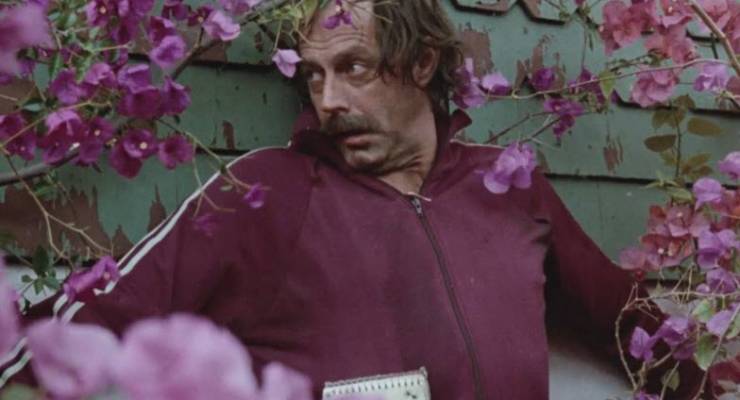
Sacred Cows is a series dedicated to overrated cultural artefacts and the more deserving ones we’ve lost sight of in their shadows. Each installment will pose an argument for one or the other, re-evaluating the worth of a text and the praise it has (or hasn’t) received.
This week, David Latham makes the case for the 1985 Australian film Bliss.
A big trap for ambitious filmmakers is to fall in love with a literary novel. Problems of drift and focus can occur when trying to translate the interior reflections of literary fiction into screen language. The 1985 Australian film Bliss certainly was an ambitious project for this reason, owing to the somewhat high-toned literary structure of Peter Carey’s 1981 Miles Franklin Award-winning novel on which the film was based.
For first-time director, Ray Lawrence — who had met Peter Carey in the world of advertising –perhaps those doubts never entered into calculations, and surprisingly, it’s this big risk that makes Bliss notable in the history of Australian film.
Bliss follows the story of advertising executive and raconteur, Harry Joy, who dies of a heart attack one afternoon during a family lunch. After being brought back to life, Harry’s life appears a sort of purgatory. He takes stock of his family’s depravities, has a brief sojourn to a psych hospital, Harry becomes smitten with a bee-crazy hippy named Honey Barbara who makes occasional visits to the city as a sex worker to help sustain her communal life in the rainforest. Harry’s journey involves the repudiation of the base materiality of his world and is a chalk-out to some degree of Carey’s own occupations and proclivities in the late 1970s.
Bliss certainly made an impact on the Australian and international film community when it landed. When it showed at Cannes, 400 of the 2000 strong audience walked out of the screening, eliciting a forthright headline from The Daily Telegraph: “Caning at Cannes: Bliss Bombs”. It was the second largest walk-out behind Michelangelo Antonioni’s L’Avventura in 1960.
Owing to its risqué content — notably an allusion to an incestuous sex-for-cocaine exchange between Davey and sister Lucy — the $3.3 million Bliss could not find an Australian distributor, and then had to fight the R-rating it was given by the censor. It never recouped its investment at the box office, collecting just under $2 million.
The critical response, however, was more fulsome. Film critic David Thomson invited Lawrence to screen Bliss at the New York Film Festival, and in Australia the film slowly built momentum, eventually picking up AFI awards for best picture, director and screenplay in 1985. Despite this, it’s never been widely revered by Australian audiences.
But what of the film itself? Bliss begins with a literary monologue on “Vision Splendid” which acts as a prologue to the film. The voiceover is accompanied by a surreal, quasi-apocalyptic visage of a robed woman holding a gold crucifix on a boat, floating across a flooded suburban street. We then cut to Harry who is delivering the monologue as he sits amongst his friends and family at the lunch table, before stepping outside to have a smoke and a heart attack.
To this point, it’s all very straightforward in film terms. We understand the world of the protagonist and have a clear inciting incident. Thereafter the film struggles to create any tautness, owing perhaps to its two-act structure. Like a biopic, at times it tends to move from situation to situation without any great sustaining drive. The character of Honey Barbara, Harry’s commune-living love interest who enters halfway through the film, I must say I found grating and whatever appeal she held in the novel translated terribly on screen.
But this is a film of moments and tone, theme and style; an arthouse film with an Antipodean twist. There are dream-like moments in the film; although they’re not at full-blown Fellini levels, which was presumably too far to reach even for an ambitious young director. But in Australian style, they are reined in. There are also surreal moments that are Lynchian, such as when the lover of Harry’s wife Bettina bursts into a fireball on the sofa.
Its value as a film lies in its status as a trailblazer. It showcased new possibilities in the Australian filmmaking industry, as a corrective to our hitherto obsession with national identity branding, social realism or recreationist drama. Along with films like Monkey Grip it opened up vistas quite urbane and distinct from the usual shibboleths of Australian film, as evidenced in films like Breaker Morant, The Man from Snowy River, Gallipoli, or Phar Lap.
And beyond questions of theme, Lawrence brought subtle stylistic elements to the Australian film palette. One shot sequences, master shots, long takes, slow dollys, natural lighting and almost non-existent dubbing gave the film a different gloss and a less harried aesthetic. The stylistic conventions Lawrence used here helped render a much more affecting form of naturalism too; his 2001 film Lantana being a prime example.
Sure, Lantana is far superior to Bliss as a film, but Bliss deserves a special place in Australian film history for its bold foray into the murky and often unforgiving terrain of the literary film adaptation.








Thanks. Some years back curated an exhibition about Sydney as a movie location, a task which involved having at least a quick look at every movie made here during the 20th century.
Bliss absolutely stood out from the worthy realism of the “Australian new wave”, and showed that so much more was possible. Its too long and rambles a lot but has some unforgettable scenes and character.
Thanks again.
Thanks. Some years back curated an exhibition about Sydney as a movie location, a task which involved having at least a quick look at every movie made here during the 20th century.
Bliss absolutely stood out from the worthy realism of the “Australian new wave”, and showed that so much more was possible. Its too long and rambles a lot but has some unforgettable scenes and character.
Thanks again.
Perhaps Bliss might have done better if it had some music in it.
Bliss is still one of my favourite Australian movies. It has a very nice soundtrack too. Sydney has changed a lot since 1985….watching traffic driving over Glebe Bridge before the monorail seems a bit of a novelty now.
….I meant Pyrmont Bridge (not Glebe Bridge)
Bliss is far more entertaining than Lantana.